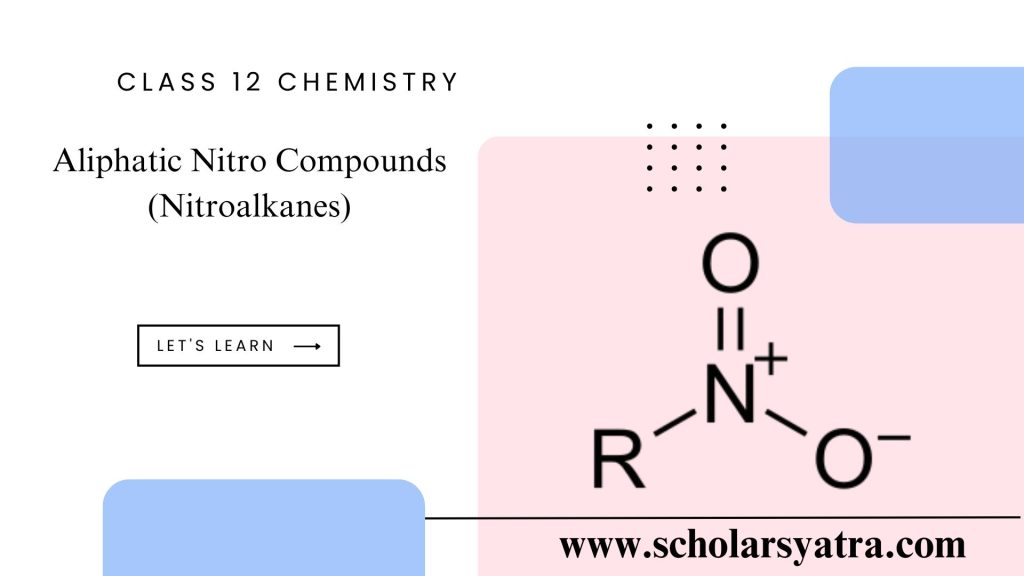Aliphatic nitro compounds are organic compounds that contain one or more nitro groups (-NO₂) attached to an aliphatic carbon atom. These compounds are known for their diverse applications in organic synthesis and industrial processes.
Table of Contents
ToggleAliphatic Nitro Compounds
Compounds in which the nitro group( – NO2) is directly bonded to the carbon atom of an alkyl group are called aliphatic nitro compounds or simply nitroalkanes. These are also regarded as nitro derivatives of alkane.
General Formula:
The general formula for simple aliphatic nitro compounds is R-NO₂, where:
- R is an aliphatic group, such as an alkyl group (e.g., CH₃-, C₂H₅-).
Examples:
- Nitroethane (C₂H₅NO₂)
- Nitromethane (CH₃NO₂)
- 2-Nitropropane [(CH₃)₂CHNO₂]
Classification of Nitro compounds
Nitro compounds are classified as primary (10), secondary (20), tertiary (30) nitroalkanes according to the nitro group( – NO2) is bonded to primary (10), secondary (20), and tertiary (30) carbon atoms respectively.
Primary nitroalkanes: If the nitro group is attached to the primary carbon, then they are called primary nitroalkanes.
Example: RCH2NO2
Secondary nitroalkanes: If the nitro group is attached to the secondary carbon, then they are called secondary nitroalkanes.
Example: R2CHNO2
Tertiary nitroalkanes: If the nitro group is attached to the tertiary carbon, then they are called tertiary nitroalkanes.
Example: R3CNO2
Nitro alkanes are alkane derivatives in which a nitro group replaces one or more hydrogen atoms. Nitroalkanes are employed as solvents in the production of oils, fats, shellac, and cellulose. Nitroalkanes are used in the manufacturing of oils, fats, shellac, and cellulose derivatives as solvents. They are utilized in the synthesis of primary amines, carboxylic acids, and their derivatives.
Nomenclature of Nitro Compounds
The naming of aliphatic nitro compounds follows the IUPAC conventions:
- Identify the longest carbon chain containing the nitro group.
- Assign a number to the carbon atom bearing the nitro group, starting from the end closest to the functional group.
- Use the prefix “nitro” to indicate the presence of the nitro group.
Examples:
- CH₃NO₂: Nitroethane
- CH₃CH₂CH₂NO₂: 1-Nitropropane
Isomerism In Nitroalkane
Two or more compounds with the same molecular formula but different properties are called isomers. This phenomenon is known as isomerism. Isomers that arise due to different structural formulae are called structural isomers.
Nitroalkanes Show Following Types of Structural Isomerism
i) Chain Isomerism: Isomers that differ in carbon chains are called chain isomers. Nitroalkanes containing at least four carbon atoms show chain isomerism in which isomers differ in the carbon chain.
ii) Positional Isomerism: Isomers that differ in the position of a functional group or substituent on a carbon chain are positional isomers. Nitroalkanes containing at least 3 carbon atoms show positional isomerism in which isomers differ in the position of the nitro group.
iii) Functional Isomerism: Isomers that differ in the functional group are called functional isomers. Nitroalkanes are functional isomers with alkyl nitrite. The compounds in which NO2 is bonded to the alkyl group to the nitrogen atom are called nitroalkanes whereas the compounds in which NO2 is bonded to the alkyl group through the oxygen atom are called alkyl nitrites.
Preparation of Aliphatic Nitro Compounds
I. From Haloalkanes
Haloalkanes react with an alcoholic solution of silver nitrite (AgNO2) to form corresponding nitroalkanes.
MECHANISM:
Nucleophiles: They are defined as the electron-rich species that donate an electron pair to an electron-deficient center forming a new bond. The substitution reaction involving having an initial attack of nucleophiles is known as nucleophilic substitution reaction.
Ambident nucleophiles: In nitrite ion (NO2–), both Nitrogen and Oxygen have an unshared pair of electrons that can donate to the electron-deficient site of the substrate ( i.e. haloalkane). So nitrite ion has two attacking sites i.e. oxygen and nitrogen atom through which it attacks electron-deficient sites i.e. haloalkane. The attack through a negative oxygen atom of NO2– on haloalkane forms alkyl nitrite . The attack through the nitrogen atom of NO2– on haloalkane forms nitroalkanes. Ambident nucleophile is defined as a nucleophile having two possible attack sites through which it attacks electron-deficient species.
II. Nitration of Alkane
Nitroalkane can be prepared by passing the mixture of alkane and nitric acid vapor at 4000C. The reaction involving the substitution of hydrogen of alkane of nitro group is called nitration of alkane. Alkanes can be nitrated by reacting them with nitric acid (HNO₃) in the presence of sulfuric acid (H₂SO₄).
R−H+HNO3→R−NO2+H2O
Physical Properties of Nitroalkanes
- State: Lower members (e.g., nitromethane, nitroethane) are liquids; higher members may be solid.
- Color: Typically pale yellow or colorless.
- Boiling Point: Nitro compounds have relatively high boiling points due to strong dipole-dipole interactions.
- Solubility: They are moderately soluble in water and highly soluble in organic solvents like ethanol and ether.
Chemical Properties of Nitroalkanes
- Acidity: Nitro compounds exhibit weak acidity due to the electron-withdrawing nature of the nitro group. They can form salts with strong bases.
- Reduction: Nitro compounds are readily reduced to amines using reagents like Sn/HCl or catalytic hydrogenation.
R−NO2+6[H]→R−NH2+2H2O
- Nucleophilic Substitution: The α-carbon (adjacent to the nitro group) is acidic and can undergo substitution reactions.
- Thermal Decomposition: Nitro compounds decompose on heating, often producing gases like CO₂, NO, and N₂.
- Reaction with Aldehydes/Ketones (Henry Reaction): Nitroalkanes react with aldehydes or ketones in the presence of a base to form β-nitroalcohols.
R−CHO+R′−NO2→R−CH(OH)−C(NO2)−R′
Applications of Preparation of Aliphatic Nitro Compounds
- Industrial Use:
- Used as solvents (e.g., nitromethane).
- Precursors for the synthesis of amines and other compounds.
- Components of explosives (e.g., nitroglycerin is derived from nitration).
- Pharmaceuticals:
- Serve as intermediates in the production of drugs.
- Laboratory Reagents:
- Used in organic synthesis for reactions like the Henry reaction.
- Agriculture:
- Intermediate products in the production of pesticides.
Aliphatic nitro compounds play a vital role in chemistry and industry. Their distinctive physical and chemical properties, combined with versatile preparation methods, make them essential for the production of fuels, pharmaceuticals, and agrochemicals.







